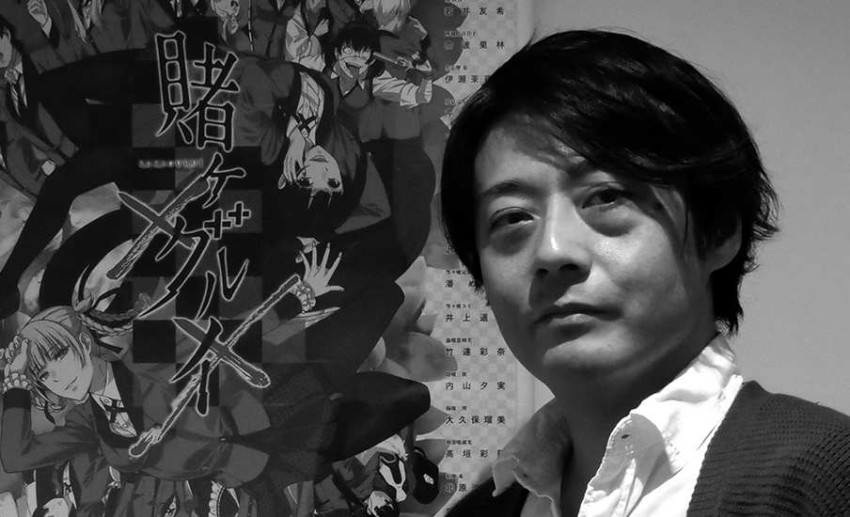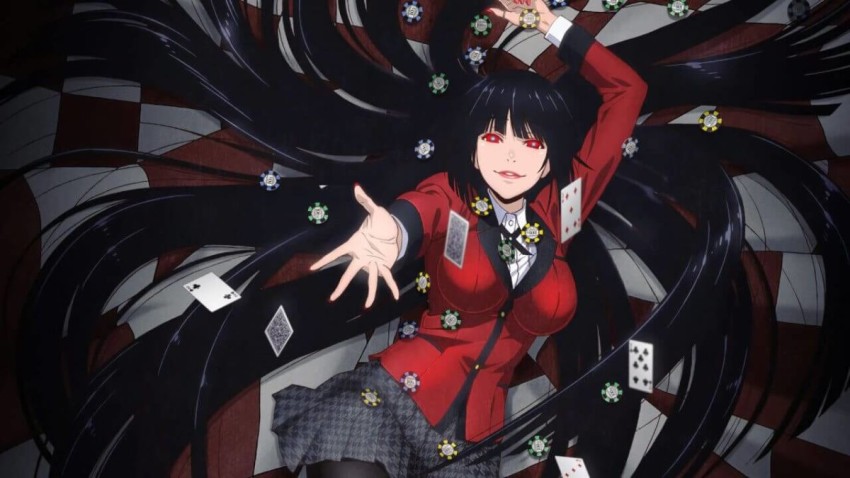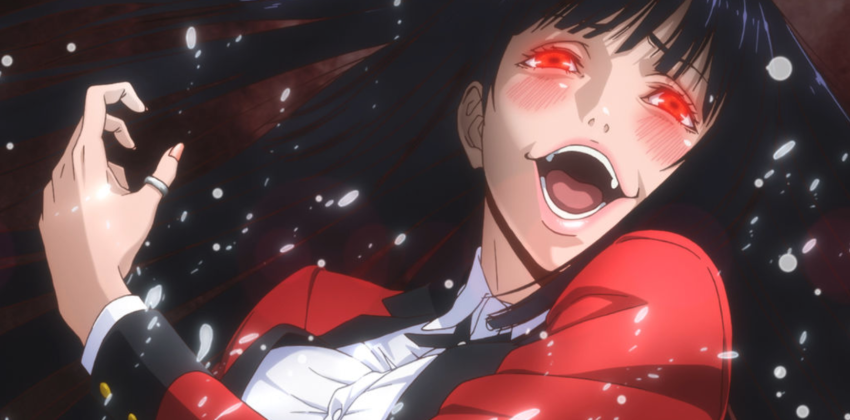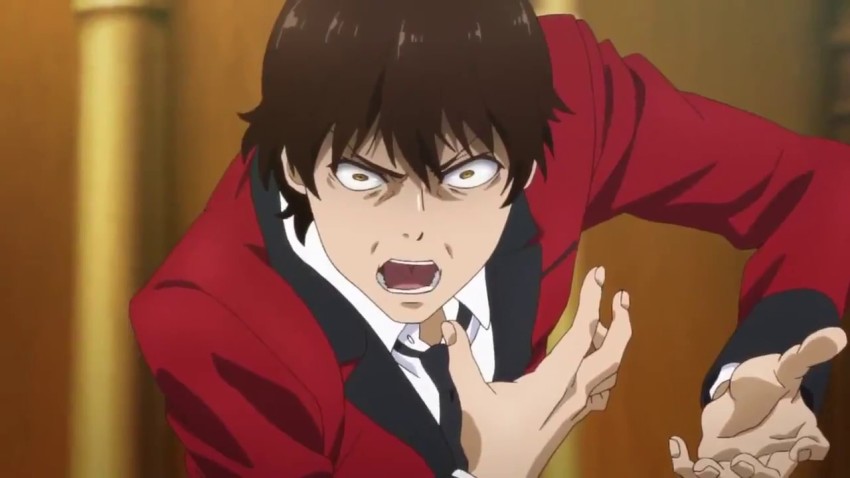Making Kakegurui
January 27, 2020 · 0 comments
By Andrew Osmond.
 Writing in NEO magazine, I described Kakegurui as a larkish, capering fight show, except that its bug-eyed duels are fought at tables with cards, gambling chips, raging egos and molten obsessions. Think Vegas on campus, with a cast of gambling-obsessed maniacs and a new girl, Yumeko, who looks like a lamb to the slaughter… but who turns out to be the most maniacal of all. She’s voiced in Japanese by Saori Hayami, who often sounds on the point of a gamble-induced orgasm, continents away from her role as the deaf Shoko in A Silent Voice.
Writing in NEO magazine, I described Kakegurui as a larkish, capering fight show, except that its bug-eyed duels are fought at tables with cards, gambling chips, raging egos and molten obsessions. Think Vegas on campus, with a cast of gambling-obsessed maniacs and a new girl, Yumeko, who looks like a lamb to the slaughter… but who turns out to be the most maniacal of all. She’s voiced in Japanese by Saori Hayami, who often sounds on the point of a gamble-induced orgasm, continents away from her role as the deaf Shoko in A Silent Voice.
Just before Netflix released Kakegurui’s second season, entitled Kakegurui ××, I had the chance to interview its director Yuichiro Hayashi when he visited the MCM London Comic Con. Hayashi had much to say, musing on the nature of anime and adaptation, and if he’d like to do even more extreme anime on online platforms. Let’s get to it…
When did you begin in the anime industry?
I started with Inuyasha, by Sunrise studio [based on Rumiko Takahashi’s manga about a time-slipping schoolgirl and a half-canine spirit]. I worked on both the in-betweens and the key animation.
 Did you ask to be put on Kakegurui, or did someone else think you were a good fit?
Did you ask to be put on Kakegurui, or did someone else think you were a good fit?
I didn’t personally request to be on the project. About the time we were finishing up on Garo, it was suggested as my next project by Manabu Otsuka, the CEO of MAPPA. It was at that point that I was handed the manga and learned about Kakegurui.
Why do you think you were chosen to direct the project?
Garo [which Hayashi directed] was quite a full-throttle action series. Kakegurui was something completely different: MAPPA was looking into expanding its genre pool, looking into new works and genres that it hadn’t taken on up to that point. I was also thinking at that point that I really wanted to challenge myself as a director, and expand my own horizons in both direction and animation, with regards to the kind of projects I could tackle.
Initially when Otsuka handed me the project, we looked at the manga and said: [the characters] are more or less staying in the same classroom, they don’t really move, there’s not a huge amount of action. After coming off a project like Garo, it should be a good way to cool down. That ended up not being the case, as I’m sure you could tell from watching the series.
In Kakegurui, I was especially struck by the characters’ faces, the crazy distorted expressions of people going mad with hate or fury or lust… The faces seem to drive the series. Did you have to look for artists who could handle these crazy expressions?
No, we didn’t go too much out of our way to find animators who specialised in that kind of over-the-top expression. But I had great faith and trust in our supervising animator, Manabu Akita, who’s a really incredible animator. He would check the final animation, and I had faith that once he looked at it, it would be the way I’d envisioned. Also, I made sure that when I was drawing the storyboards the characters’ expressions came across clearly, and were as close to the final animation as possible. We sat down and decided things at the storyboard stage so we could avoid inconsistencies down the road.
 Kakegurui originated as a manga (written by Homura Kawamoto, drawn by Toru Naomura), and there’s a live-action Japanese TV version which can be watched alongside the anime on Netflix. In your view, what strengths and specialities does anime have in telling the story, which are not shared by other media?
Kakegurui originated as a manga (written by Homura Kawamoto, drawn by Toru Naomura), and there’s a live-action Japanese TV version which can be watched alongside the anime on Netflix. In your view, what strengths and specialities does anime have in telling the story, which are not shared by other media?
I think one of the really big differences between the manga and anime relates to the location and backgrounds. In the manga, the locations are not perhaps as clear-cut, because you don’t necessarily have characters physically moving through those spaces in a three-dimensional sense. So you don’t have to be as detailed or specific about where this action is taking place; what’s going on where.
One of the things you have to do when adapting a manga to anime is lock down the location: Where is this happening? We wanted to bring a sense of reality to the location, to the school as a school, so people could imagine this is where these kids are actually going to school and gambling.
One other interesting things about animation is that you have complete control over colour and lighting. You do have it in live-action in a sense, but not as much as in animation. This is another way you can add a kind of emotional magnitude to a scene. One thing I really wanted to use effectively was evening light, and moonlight, and different kinds of light… To add these different colour aspects to give scenes an emotional feel and range that wasn’t necessarily present in the manga.
The performances of characters are down to the animators; where the characters are placed in a scene, where they are in the frame, how they move through the frame. These aspects of filmmaking are all things we control and the way we go about each varies greatly between the three mediums… And we work to solidify what each game looks like, the atmosphere surrounding it and how the students interact with each other; not just those involved in the gamble but the other students surrounding them, how they act, how they behave.
We got to add quite a few original aspects that aren’t necessarily depicted so clearly in the original manga. They bring (Kakegurui) together and show it as one cohesive space where these events are taking place. It was those sorts of areas where we could extrapolate and build on what was in the manga. We thought long and hard about how to bring that into a three-dimensional space that these characters inhabit, that a space that can have an emotional magnitude and validity for those watching the series.
In many anime and manga, there are quite a few expressions or mannerisms that are often used to portray certain feelings or emotions. I wanted to stay away from those kind of generalized expressions, especially facial expressions, which are often overused. To that effect, we thought a lot more about how we would film Kakegurui if it was live-action and get away from the boundaries that ideas of “traditional” and “typical” Japanese animation create. We wanted to give Kakegurui more three-dimensionality than it perhaps had in the manga, or that you might find in a typical animation series.
I’m very glad that we created the Kakegurui anime before the live-action version was made, because it was often (our) thinking, “How would we film this as live-action?” that got us to the finished frames, the finished product that you see, and give it a more three-dimensional aspect. I feel that because the anime was created before the live-action version, the live-action actually takes a bit from the anime, perhaps copies some of the expressions and the ways we went about showing the scenes. So I’m very glad we got to do the animation first.
 You’ve talked about how you need to build upon and sometimes change the manga to make it work better in anime. Obviously a great many anime are adapted from manga. Are there any fans that become annoyed and resistant if an anime tries to be creative with the source material? Do they complain if they think the manga is changed too much?
You’ve talked about how you need to build upon and sometimes change the manga to make it work better in anime. Obviously a great many anime are adapted from manga. Are there any fans that become annoyed and resistant if an anime tries to be creative with the source material? Do they complain if they think the manga is changed too much?
From the beginning, when we were working on the script for Kakegurui’, we had the editors from Square Enix and the original (manga) author there working with us [Square Enix publishes the manga magazine Gangan Joker where Kakegurui is serialised.] It was our plan from the beginning to be faithful to the source material. If we did go too far off track, then the editors would bring us back. So I wasn’t too concerned that we would end up with a product that would anger the fans, which would be too far from the manga.
That being said, as you go along, the script will move from being an adaptation of the original manga to being a fully fledge anime script that can stand on its own; it will often evolve into something else. Creating a script is a collaborative effort, it will include ideas from myself, things I personally wanted to add, and ideas from other people, and as we propose these ideas the script takes on a life of its own. That being said, I feel that often with these kinds of projects, to show something faithfully, to bring something to the screen that fans will enjoy, you must almost be a mega-fan yourself. You have to get to the point where you can almost understand the source material even more than a typical fan… so that you know that even if you change something, the fans won’t be too upset about it because you wouldn’t be too upset about it.
You really have to put yourself in the headspace of the fans. It comes down to: as you are in essence a fan, what you want to see will, in some ways, line up with what the fans want to see.
In your talk at MCM London Comic Con, you mentioned you weren’t sure how far you could push some of Kakegurui’s content, as the anime was broadcast on TV in Japan. At the moment, there are anime being made just for streaming, being put onto platforms like Netflix; for example, last year’s very explicit series Devilman Crybaby. Do you think that kind of platform offers a good way to push anime further, with material too strong for TV?
I really feel the possibilities with new streaming services. Especially when I was watching Devilman Crybaby, I was shocked and really excited by how freely the creators seemed to tackle the series. Watching, I thought it must be really fun for creators to be in an environment where you don’t have as many rules and regulations to worry about.
I would like to be able to challenge myself on that kind of platform and format. The length of each episode is quite flexible on Netflix… You don’t run into the issues we have making broadcast animation. There’s no need to cut scenes which you wanted to include because of the [broadcast] time limit. So in that sense I feel [the online platforms] are perhaps an Eden for creators, where you can go to town and create what you want to create.
That said, in broadcast animation you reach decisions about the project because it is a broadcast medium. You wouldn’t necessarily reach those decisions on a more free-form platform. In that sense, broadcast TV tests us as creators; how can we tell the story in this limited time that we have? Because of that, I feel there are things that are born from the need to condense everything into 22 or 24 minutes, which might get lost on a more open, freeform platform.
I’m not convinced that it’s necessarily best to let the creators have the run of the place, and go completely free. But it’s something that I am very excited about, and hope I will have the chance to work on in the future.
Kakegurui and Kakegurui xx are currently streaming on Netflix.
Leave a Reply